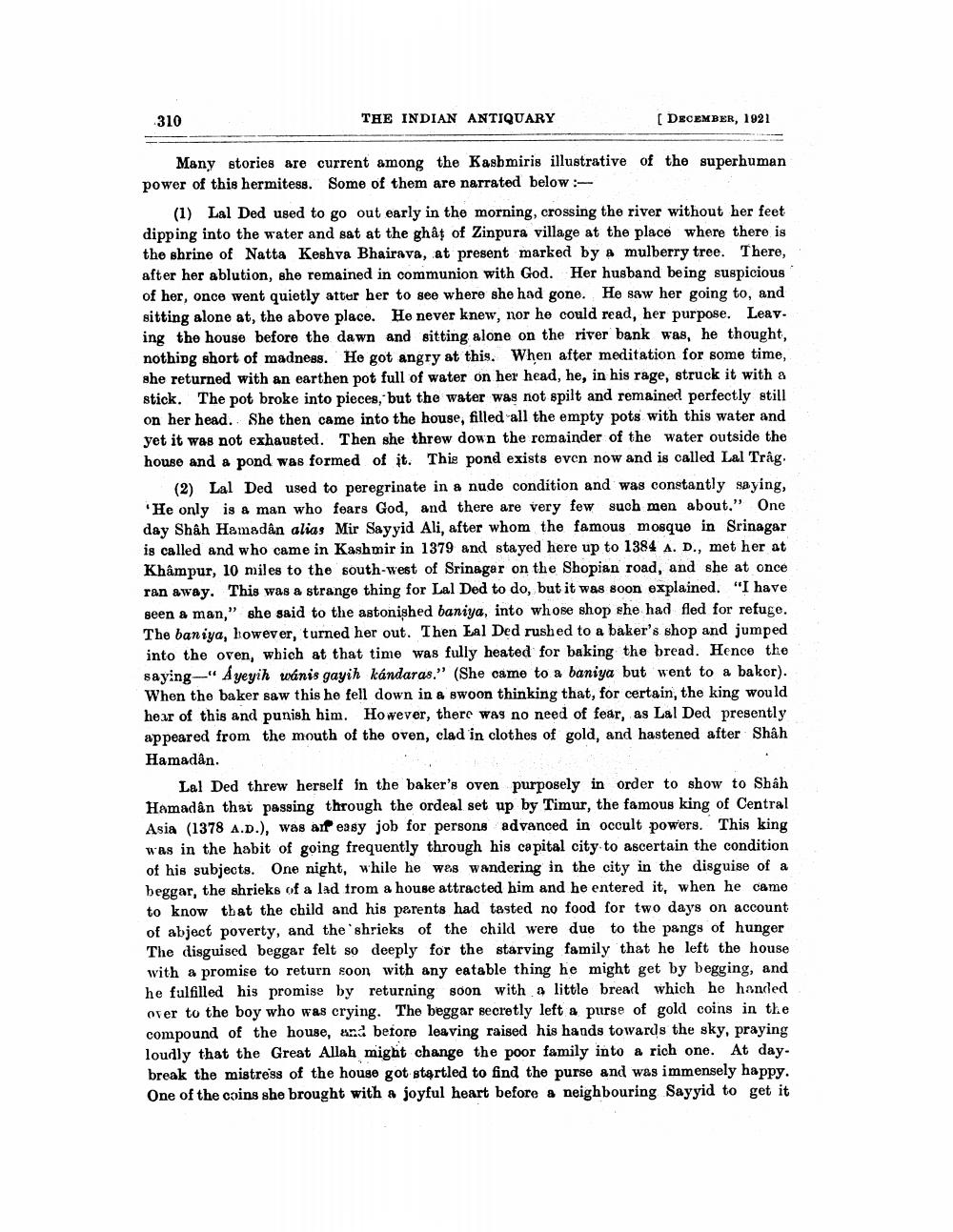________________
310
THE INDIAN ANTIQUARY
DECEMBER, 1921
Many stories are current among the Kashmiris illustrative of the superhuman power of this hermitess. Some of them are narrated below:
(1) Lal Ded used to go out early in the morning, crossing the river without her feet dipping into the water and sat at the ghat of Zinpura village at the place where there is the shrine of Natta Keshva Bhairava, at present marked by a mulberry tree. There, after her ablution, she remained in communion with God. Her husband being suspicious of her, once went quietly atter her to see where she had gone. He saw her going to, and sitting alone at, the above place. He never knew, nor he could read, her purpose. Leay. ing the house before the dawn and sitting alone on the river bank was, he thought, nothing short of madness. He got angry at this. When after meditation for some time, she returned with an earthen pot full of water on her head, he, in his rage, struck it with a stick. The pot broke into pieces, but the water was not spilt and remained perfectly still on her head. She then came into the house, filled all the empty pots with this water and yet it was not exhausted. Then she threw down the remainder of the water outside the house and a pond was formed of it. This pond exists even now and is called Lal Trâg.
(2) Lal Ded used to peregrinate in a nude condition and was constantly saying, He only is a man who fears God, and there are very few such men about." One day Shah Hamadân alias Mir Sayyid Ali, after whom the famous mosque in Srinagar is called and who came in Kashmir in 1379 and stayed here up to 1384 A. D., met her at Khâmpur, 10 miles to the south-west of Srinagar on the Shopian road, and she at once ran away. This was a strange thing for Lal Ded to do, but it was soon explained. "I have seen a man,” she said to the astonished baniya, into whose shop she had fled for refuge. The baniya, however, turned her out. Then Lal Ded rushed to a baker's shop and jumped into the oven, which at that time was fully heated for baking the bread. Hence the saying-“ A yeyih wánis gayih kandaras." (She came to a baniya but went to a bakor). When the baker saw this he fell down in & swoon thinking that, for certain, the king would hear of this and punish him. However, there was no need of fear, as Lal Ded presently appeared from the mouth of the oven, clad in clothes of gold, and hastened after Shah Hamadân.
Lal Ded threw herself in the baker's oven purposely in order to show to Shah Hamadân that passing through the ordeal set up by Timur, the famous king of Central Asia (1378 A.D.), was all easy job for persons advanced in occult powers. This king was in the habit of going frequently through his capital city to ascertain the condition of his subjects. One night, while he was wandering in the city in the disguise of a beggar, the shrieks of a lad from a house attracted him and he entered it, when he came to know tbat the child and his parents had tasted no food for two days on account of abject poverty, and the shrieks of the child were due to the pangs of hunger The disguised beggar felt so deeply for the starving family that he left the house with a promise to return soon with any eatable thing he might get by begging, and he fulfilled his promise by returning soon with a little breact which he handed over to the boy who was crying. The beggar secretly left a purse of gold coins in the compound of the house, and before leaving raised his hands towards the sky, praying loudly that the Great Allah might change the poor family into a rich one. At day. break the mistress of the house got startled to find the purse and was immensely happy. One of the coins she brought with a joyful heart before a neighbouring Sayyid to get it




